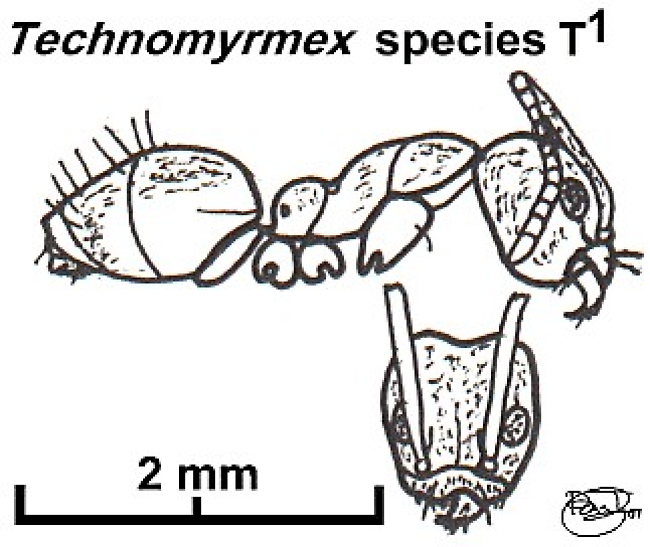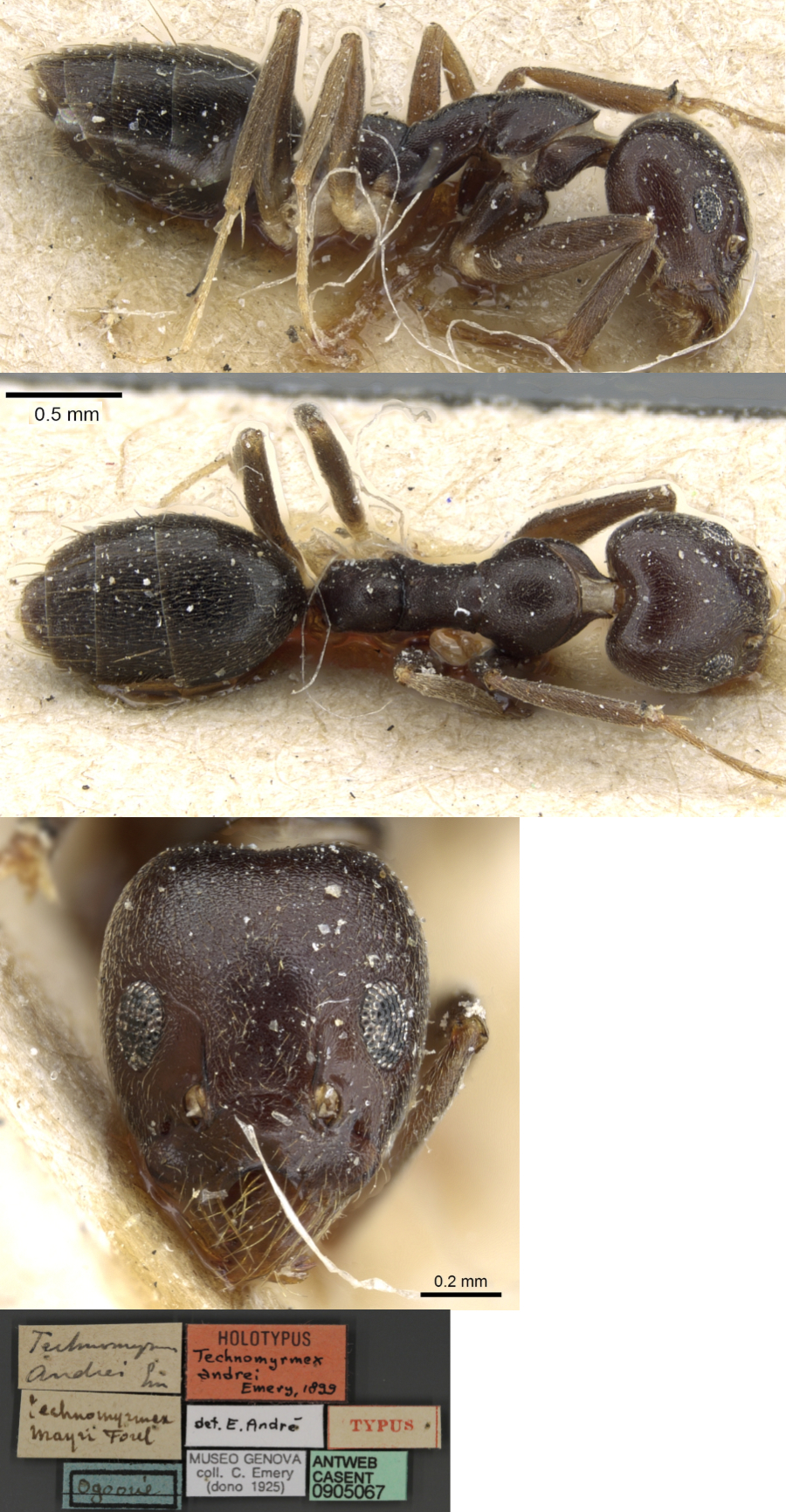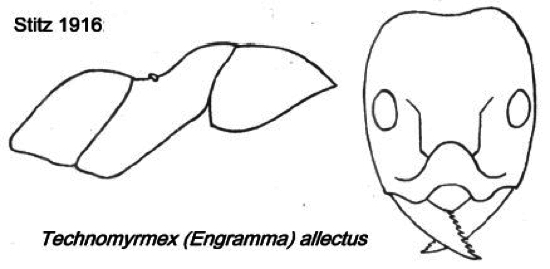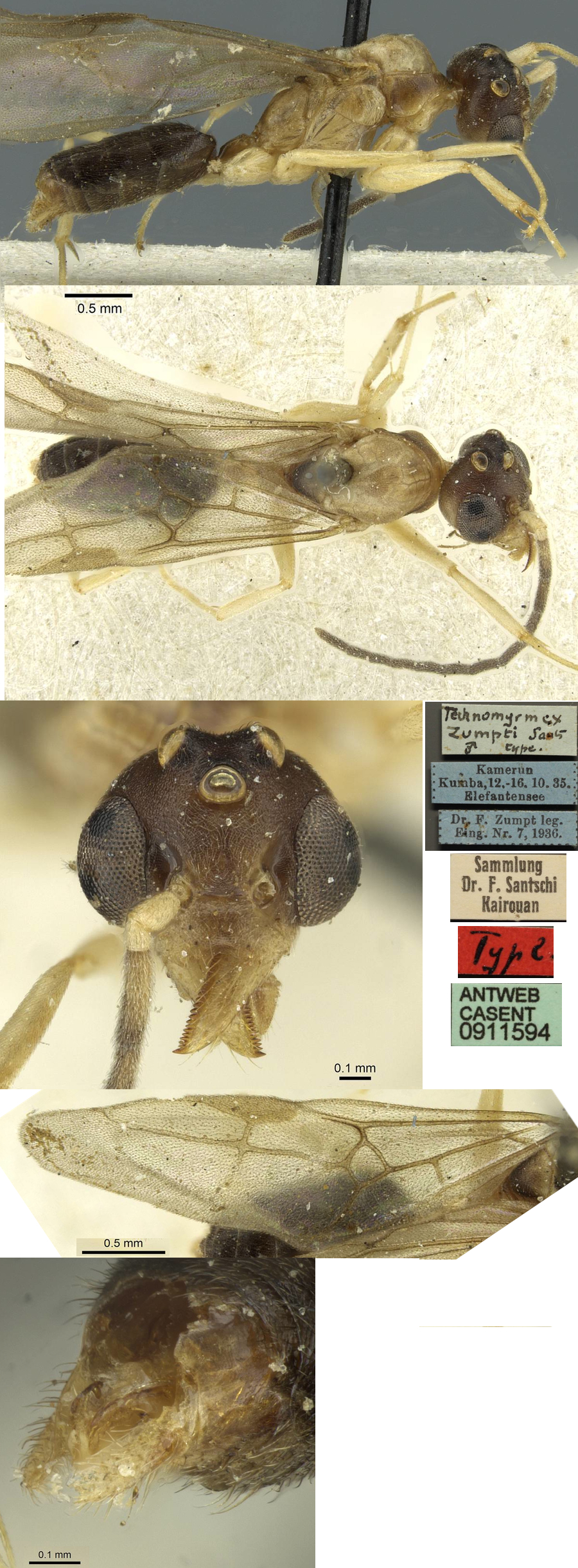Technomyrmex (Engramma) andrei Emery
  Bolton (1995) had Bolton (1995) had
Type
location Gabon (Technomyrmex
Andrei n. sp., Emery, 1899e: 488, illustrated, worker;
Bernard, 1953b, 255, queen) collected at Ogowe by Mocquerys - see below
subspecies
camerunensis (Technomyrmex
Andrei var. camerunensis
n. v., Emery, 1899e: 489, worker) from Cameroun, Conradt
schereri (Technomyrmex
Andrei Emery v. Schereri
n. var., Forel, 1911e: 283, worker) from Liberia,
collected at Cape Mount, by Scherer
workers and queen known (in
Wheeler, 1922; see Bolton, 1995)  . .
|
This
is superseded by Bolton (2007: 19)
Type location Gabon
(Emery, 1899e: 488, illustrated, worker; Bernard, 1953b, 255, queen
[not listed by Bolton]) collected at Ogowe by Mocquerys
junior
synonyms
schereri (Forel, 1911e: 283, worker) from Liberia,
collected at Cape Mount, by Scherer - no images on Antweb (April 2015)
wolfi (Engramma Wolfi n. sp.,
Forel, 1916: 432, worker, illustrated; Wheeler, 1922: 204, queen &
male [not mentioned by Bolton]) type location Zaïre, from St.
Gabriel, collected by Kohl - see http://www.antweb.org/specimenImages.do?name=casent0909758
allecta (Engramma allecta,
Stitz, 1916: 394, illustrated, worker) type location Zaïre,
collected at Koloka, near Angu, by Schubotz - no images on Antweb (April 2015)
zumpti
(Santschi, 1937b: 102, male) type location Cameroun, at
Elefantsee, Kumba, Mt. Cameroun?, by F. Zumpt, xi. 1935; single male
only described - see below.
Bolton (2007) has separated Technomyrmex
camerunensis as a definitive species.
|
 Emery's
(1899e) description, with camerunensis,
is at Emery's
(1899e) description, with camerunensis,
is at  . and Forel's (1911e) description of schereri
is at - . and Forel's (1911e) description of schereri
is at -  . .
My translation for schereri - "TL 3 mm; much
smaller than the type, otherwise very similar. The propodeal dorsum
(Basalfläche) is much shorter and the declivity distinctly steeper,
with somewhat stumpier angles. Black, coxae, tarsi pale yellowish;
antennae, mandible and rest of leg brown. The variety camerunensis
is even closer to the type form."
There is a conflict between the Emery (1899e)
description and drawing and Bolton's separation of andrei
and camerunensis. Emery explicitly described camerunensis
as less slender, the head less elongated, the scape surpassing the
occiput by one-third its own length, the profile of the propodeum with
a very rounded obtuse angle. Bolton makes no reference to this. Now
(2014), using the digital method of image layering the profile
drawings and the type worker photographs confirms the drawings were
mislabelled. Therefore I am not including the Bolton drawing here.
Wheeler (1922) also listed findings from Cameroun
(Conradt) and Zaïre (Kinshasa, by Waelbroeck).
Bernard (1952) reported findings from Mt. Nimba, Guinea;
numerous workers and an alate queen, differing slightly from the type
in colour and diverse details, but certainly of this species - the most
common in French West Africa. Collected at N'Zo, Nion crest at 1300 m,
and in leaf litter sifting (Villiers). Mainly an insect of grassland.
|
Bolton's
(2007) fresh description is at  . .
Characteristic of Bolton's approach, he chose to
synonymize several older "species", arguing that the "supposed
differences are taxonomically insignificant and are well within the
range of variation seen among workers of this species".
On that argument, his separation of Technomyrmex parandrei
seems quite weak. From those that I have seen (listed below) the
dramatic colouration of the worker from the Central African Republic on
Antweb is not common.
|
 Nigeria specimens (as Technomyrmex
species
T¹, Taylor, 1978: 53). WORKER. 53) TL 3.73 mm, HL 1.01, HW 0.92, SL
1.03, PW 0.61 Nigeria specimens (as Technomyrmex
species
T¹, Taylor, 1978: 53). WORKER. 53) TL 3.73 mm, HL 1.01, HW 0.92, SL
1.03, PW 0.61
Colour dark red-brown to black, extremities lighter and coxae of mid-
and hind-legs white, shiny. Erect hairs sparse and confined to clypeus
and gaster, although none on the first gastral segment. Fine pubescence
all over. Sculpturation of very fine reticulation, especially on the
alitrunk. Anterior clypeal border is deeply emarginate. Propodeum
convexly humped in profile.
Found nesting in soil. Occasionally seen tending aphids on cocoa, also
recorded constructing a soil tent over mealybugs, but not associated
with black pod disease. Tents were found at the Cocoa Research
Institute of Nigeria, Idi Ayunre, and Oloruntedo, near Ondo.
As Technomyrmex species T¹ in Taylor (1981) but
listed without reference by Bolton (2007).
|
 The
photomontage of the holotype worker is collated from - http://www.antweb.org/specimen.do?name=casent0905067 The
photomontage of the holotype worker is collated from - http://www.antweb.org/specimen.do?name=casent0905067
|
Oxford University Museum
specimens
Technomyrmex andrei
B Taylor det. |
Liberia
E Poirier
Liabala
PF 14
|
2.iv.2013
Nimba County
07°31’06" N
08°35’34" E
|
Pitfall trap
Secondary forest
473 m asl
|
1
|
 |
Technomyrmex andrei
B Taylor det. |
Liberia
E Poirier
Liabala
PF 15
|
2.iv.2013
Nimba County
07°31’06" N
08°35’34" E
|
Pitfall trap
Secondary forest
473 m asl
|
1
|
 |
Technomyrmex andrei
B Taylor det. |
Liberia
E Poirier
Yekepa
PF 20
|
29.iii.2013
Nimba County
07°33’38" N
08°32’33" E
|
Pitfall trap
Degraded secondary forest
518 m asl
minor
|
1
|
 |
Technomyrmex andrei
B Taylor det.
|
Cameroun
A Fotso Kuate
Sample 48
|
5.v.2007
Awae II
03°54'30" N
11°25'58"
|
aphid survey
Relatively light brown
|
2
|
 |
Technomyrmex andrei
B Taylor det. |
Cameroun
A Fotso Kuate
Sample 24
|
3.ix.2008
Batcham
03°54'30" N
11°25'58"
|
aphid survey
|
2
|
 |
Technomyrmex andrei
B Taylor det. |
Gabon
Y Braet
Gabon 218
|
27.vi-10.vii.2006
Pongara
00°34' N
09°19' E
|
Leaf litter, winkler
funnel
|
2
|
 |
Technomyrmex andrei
B Taylor det. |
Gabon
A Fotso Kuate
Sample 32a
|
12.ix.2008
Tog
03°54'30" N
11°25'58"
|
|
1
|
 |
Technomyrmex andrei
B Taylor det. |
Congo
E Zassi
18-t-1-1
|
16-17.xi.2007
Lésio-Louna
03°16'56.5" S
015°28'28.3" E
|
Wooded Savannah; 24h
pitfall trap
|
1
|
 |
Technomyrmex andrei
B Taylor det. |
Central African
Republic
P Annoyer
|
15-18.x.2008
Dzanga-Sangha
03°03'58.3" N
16°08'59.6" E
|
Camp 1
|
4
|
 |
Technomyrmex andrei
B Taylor det. |
Central African
Republic
P Annoyer
ME
|
18.xi.2010
Dzanga-Sangha
2°28'45.9"N
16°13'15.0"E
|
396 m; nuit, à vue,
camp transit 2 près lac 1
|
1
|
 |
|
 The
photomontage is of a worker from Congo, Réserve de
Lésio-Louna, S 03°16'56.5" E 015°28'28.3"; 16-17.xi.2007; n sp 02;
pitfall trap 18, t 1.1; wooded savannah; collected by Eric Zassi. The
photomontage is of a worker from Congo, Réserve de
Lésio-Louna, S 03°16'56.5" E 015°28'28.3"; 16-17.xi.2007; n sp 02;
pitfall trap 18, t 1.1; wooded savannah; collected by Eric Zassi.
|
 The
photomontage is of a worker Central
African Republic,
Dzangha-Sangha Nature Reserve; collector Philippe Annoyer (CAR ME) The
photomontage is of a worker Central
African Republic,
Dzangha-Sangha Nature Reserve; collector Philippe Annoyer (CAR ME)
|

Technomyrmex (Engramma) wolfi (Forel)
Type location Zaïre (Engramma Wolfi,
Forel, 1916: 423, illustrated, worker; Wheeler, 1922: 204, queen &
male) from St. Gabriel, collected by Kohl; combination in Technomyrmex
by Shattuck (1992b); all forms described (Bolton, 1995).
Forel's (1916) description is at  . .
Wheeler (1922, with the illustration) noted collections
from Akenge, Ngayu and Medje (Lang & Chapin); Walikale to Lubutu
(J. Bequaert).
FEMALE (undescribed) - Length 4.6 to 5 mm. Very similar
to the worker. Head scarcely excavated behind. Eyes about two-fifths as
long as the sides of the head. Clypeal border each side of the notch
flattened and angularly projecting. Head and thorax a little more
finely punctate and therefore a little more shining than in the worker.
Propodeum feebly convex, sloping, without distinct base and declivity.
Dark brown; mandibles, antennae and wing-insertions pale brown; legs,
including the coxae, white, with a dark brown band around each femur
and the tips of the hind coxae of the same color. Wings grayish
hyaline, with pale brown veins and pterostigma.
MALE (undescribed) - Length nearly 3 mm. Head through
the eyes as broad as long. Eyes and ocelli large. Mandibles well
developed, decussating, with long, very finely and evenly denticulate
apical borders. Clypeus short, with nearly straight, entire anterior
border. Antenna long and slender; scape and all joints, except the
first funicular, cylindrical; the latter as broad as long but not
broader than the succeeding joints. Thorax short, not broader than the
head; the mesonotum broader than long, not overhanging the pronotum.
Propodeum sloping, without distinct base and declivity. Petiole with
more distinct trace of the node at the anterior end than in the worker.
Genitalia moderately large, exserted. Legs slender. Wing venation as in
the female. Sculpture and pilosity much as in the female, the hairs and
pubescence being very sparse and short, the former apparent only on the
mouth-parts and tip of the gaster. Dark brown; front of head and three
large spots on the mesonotum pale rusty brown; mandibles pale
yellowish; scapes, first funicular joint, and legs, including the
coxae, sordid white; the femora without brown bands. Wings and their
veins a little paler than in the female.
The specimens from Akenge, Ngayu, and Medje (a female
and four workers) were taken from the stomachs of toads (Bufo
polycercus, superciliaris, and funereus), those
from Walikale at lights. Kohl took the workers from which Forel
described the species in the virgin forest in the ground among rotten
leaves. This habit accounts for the occurrence of specimens in the
toads' stomachs.
|
 The
photomontage is of a specimen from Gabon, Pongara National
Park; collector Yves Braet (Gabon 218). The
photomontage is of a specimen from Gabon, Pongara National
Park; collector Yves Braet (Gabon 218).
|
 The
photomontage is
of a worker from Gabon; Tog;
collector A Fotso Kuate (fk
unmounted 32) The
photomontage is
of a worker from Gabon; Tog;
collector A Fotso Kuate (fk
unmounted 32)
|

Technomyrmex (Engramma) allectus (Stitz)
Type location Zaïre (Engramma allecta,
Stitz, 1916: 394, illustrated, worker) collected at Koloka, near Angu,
by Schubotz; worker only known (see Bolton, 1995).
Stitz's (1916) description is at  . .
From the illustration and the following translation by
Hauke Koch, this seems most probably to be a junior synonym of wolfi
- "Worker: TL 4mm; head at the point of the eyes as wide as the length
of the median line to the edge of the clypeus, with convex sides, which
are curved above the mandibular joints slightly less than at the back
of the head, where they descend under a very rounded angle of the
occipital corners into an almost even, slightly concave hind margin,
which is almost as wide as the head between the front corners. Eyes in
the middle of the sides of the head. Clypeus convex, posterior border
shallowly semicircular, its frontal margin in the middle third deeply,
almost semicircularly cut, the two lobes resulting from this projecting
strongly over the mandibles on both sides. The margin of the clypeus is
impressed, the lateral impressions are merged with the antennal
grooves. Frontal carinae widely separated, ahead of their apical end
shortly bent outwards and directed toward the eyes. Scapes when aligned
parallel to the median line of the head, surpassing the occiput by
slightly more than 1/3 of their length. Funicular joints 1-4 twice as
long as wide at the end, the following joints gradually decreasing in
length till the penultimate, which is 1.5 times as long as wide, the
last one is twice as long as the penultimate. Black, the head slightly
brownish, antennae brown, getting brighter to the tip of the funiculus.
Mandibles and legs light brown, at the end very bright, almost yellow.
The coxae of the middle and hindlegs as well as the following proximal
ends of the femora also are bright, almost yellow. After this
publication went to press, I got from Prof Forel "Fourmis du Congo …"
(Forel, 1916) with the description of Engramma wolfi n. sp.,
whitch seems to fit the species described here almost totally. Except
for the eyes being in the middle of the sides of the head (not behind),
there are only minor differences in the sculpture: Head and thorax are
punctuated evenly fine and dense, the lowering of the epinotum in the
same way as its basal area.
|
Technomyrmex (Technomyrmex) zumpti Santschi
Type location Cameroun (Santschi, 1937b: 102,
male) at Elefantsee, Kumba, Mt. Cameroun?, by F. Zumpt, xi. 1935;
single male only described (see Bolton, 1995).
Santschi's (1937b) description is at  . Bolton (2007, see top) noted that this matched "worker-associated males of andrei that have been examined". . Bolton (2007, see top) noted that this matched "worker-associated males of andrei that have been examined".
|
 The
photomontage of the zumpti type male is collated from - http://www.antweb.org/specimen.do?name=casent0911594. The
photomontage of the zumpti type male is collated from - http://www.antweb.org/specimen.do?name=casent0911594.
|
|